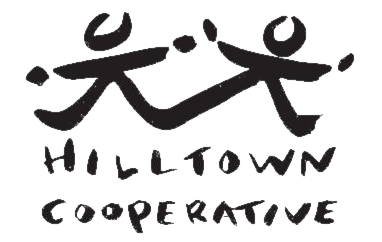 The Hilltown Cooperative Charter Public School was started in 1995 by a group of local parents, artists, and educators who sought to bring an educational alternative to the rural hill towns of western Massachusetts. These pioneers were grounded in the belief that children are our most valuable resource and schools, as a result, our most critical institution. They felt the traditional elementary school structure did not provide what is essential to the optimal education of children: a partnership of parents, teachers, and students. Our founders envisioned a school with the following five elements (excerpted here from the school”s original charter school application):
The Hilltown Cooperative Charter Public School was started in 1995 by a group of local parents, artists, and educators who sought to bring an educational alternative to the rural hill towns of western Massachusetts. These pioneers were grounded in the belief that children are our most valuable resource and schools, as a result, our most critical institution. They felt the traditional elementary school structure did not provide what is essential to the optimal education of children: a partnership of parents, teachers, and students. Our founders envisioned a school with the following five elements (excerpted here from the school”s original charter school application):
1. A child-centered approach to education.
“Creative thinking can best be encouraged in an environment in which teachers are not mere dispensers of information but rather models, resources and guides, helping children to develop their own ideas and solutions” (Duckworth 157). This relationship between teacher and student embraces the innate curiosity and rich potential of each child, rather than focusing on the student”s lacks and deficits. It also accommodates a wide range of individual learning styles, providing each child with the means to most effectively pursue his or her individual learning.
2. A collaborative approach to education.
To maintain the motivation and self-esteem of teachers, they must be empowered to make their own decisions and trusted to direct their own teaching. A cooperative, interactive school environment, in which teachers are not isolated but are in dialogue with other teachers and administrators, allows for a cross-fertilization of ideas and provides students with a model of teamwork.
3. A thematically unified experiential curriculum fully integrating the arts.
This approach, drawing from a pre-school model in Reggio Emilia, Italy, recognizes the arts as “critical tools for creative learning and self-expression” (WMHCSC 1994, 7). The arts provide a unifying language with which to explore all subject matters. Rather than dividing the curriculum into discrete, scheduled subject units with rigid time constraints, the curriculum emerges from students” interests and is linked through the study of general themes (rivers, for example). Beginning with student interests and integrating the curriculum heightens the learning process and allows students to see the interconnectedness between the sciences and the humanities.
4. Family involvement as integral to the educational process.
Parents are critical to the successful education of their children. But in most schools, there is not an open door policy; parents are not welcome in the classroom at any time. Moreover, because a curriculum is prescribed, there is less room for parents to add their expertise or bring in what they can offer. A successful school environment must provide parents with ample opportunities for in-depth, meaningful connection with their children”s experiences.
5. A school experience integrated into the rich fabric of our community and rural environment.
Stimulating scientific material lies just beyond the walls of any school. In the hill towns, there is a wealth of wilderness and agricultural resources. Utilizing these resources not only offers new curriculum opportunities; it also fosters respect for the earth.
The founders set out to create a learning environment with an emergent curriculum, integrative arts, and a high level of community involvement, all of which would build students” self-esteem, enhance critical thinking, and encourage curiosity. Charter School legislation afforded us the opportunity to demonstrate the effectiveness of such an education, in a public school unburdened by traditional hierarchies and systems. This child-centered approach, focusing on the needs of individual children and following their creative impulses, became the backbone of Hilltown”s educational philosophy, and was complimented by the school”s commitment to governance by a parent cooperative using a consensus model for decision-making.
